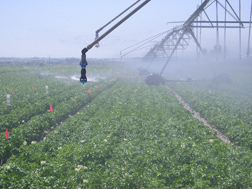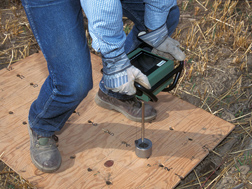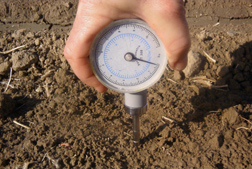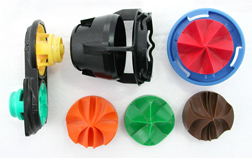New Insights Into Irrigation Management
|
|
Pacific Northwest potato and sugar beet farmers who irrigate their crops with sprinklers need to know a lot more than when to turn on the faucet. The region’s powdery silt loam soils don’t contain much stabilizing organic matter, and existing soil aggregates that facilitate water infiltration can be broken up during irrigation. Afterwards, the loose particles of sand, silt, and clay that remain can dry to form a solid crust that greatly limits infiltration into the soil.
This means that growers not only need to calculate how much water should be supplied during irrigation, but they also need to ensure that the kinetic energy transferred from each water droplet to the soil surface during irrigation doesn’t contribute to the breakup of the fragile soil aggregates. They also need to develop irrigation protocols that won’t saturate soils or erode valuable topsoil.
Agricultural Research Service soil scientist Gary Lehrsch has been studying sprinkler irrigation for more than a decade. He has used his findings to develop numerous irrigation guidelines to protect soil structure, maintain soil quality, sustain soil resources, and increase the odds that water delivered via sprinkler irrigation will reach the root zones of growing crops.
|
|
“Sprinkler heads on center-pivot irrigation systems can be inexpensively and easily modified to adjust the water volume applied per pass and the force with which the water droplets hit the soil surface,” Lehrsch says. He works at the ARS Northwest Irrigation and Soils Research Laboratory in Kimberly, Idaho.
In one 5-year investigation, Lehrsch and colleagues evaluated the effect of sprinkler-droplet kinetic energy on soil crust strength and aggregate stability. They irrigated sugar beet plots using a 500-foot, four-span, lateral-move sprinkler system equipped with sprinkler heads that were positioned 6 feet above the soil.
The sprinkler heads were modified so that irrigations had either low or high droplet energies. The scientists included test plots with nylon covers, which ensured that when those plots were irrigated, the energy in the droplets would be absorbed by the netting and not the soil surface.
After the sugar beets were planted, the plots were irrigated with 0.6 inches of water at an average rate of 1.5 inches per hour two to four times per week for 5 weeks after planting. The team measured surface-soil penetration resistance—which indicates the strength of the soil crust—about 4 days after the first postplant irrigation and 14 days after the last irrigation.
|
|
Water Worries
Lehrsch and colleagues found that aggregate stability decreased from 66 percent to 55 percent when the irrigation’s droplet energy increased from 0 percent (in the test plot with the nylon netting) to the lowest rate under investigation. Sugar beet seedling emergence increased 6.4 percent when droplet energy was reduced 50 percent from the highest rate studied, an emergence increase that could raise net income for southern Idaho sugar beet growers by nearly $6.2 million every year.
“We’ve concluded that these droplet-energy restrictions should be in place until sugar beet seedlings have emerged and become established,” Lehrsch says. “After that, sprinklers can be reconfigured to apply greater water volumes—at necessarily greater levels of energy—for the rest of the growing season.”
The researchers also observed that after multiple irrigations, soil penetration resistance decreased as droplet size and energy increased, probably because the larger droplets hit the ground with enough force to loosen soil particles and erode surface soil. They saw evidence of this erosion process during late-season irrigations when sediment-laden runoff flowed from row hills into nearby furrows and basins.
Lehrsch recommends keeping crop residues on the surface to check erosion and amending soils with organic materials such as manure or whey—the liquid byproduct remaining after cheese is made—to bolster soil-aggregate stability. These recommendations are based in part on his research that showed adding whey to furrows before irrigation increased soil-aggregate stability 25 percent at the 0- to 0.5-inch depth and 14 percent at the 0.5- to 1-inch depth.
Droplet Dynamics
In another project, Lehrsch found further evidence that irrigation comes with costs as well as benefits. “I studied how the kinetic energy in water droplets affects the infiltration of recently tilled soil,” he says. “This is a key aspect of irrigation management, because when water can’t infiltrate into the soil, it can’t enter the crop’s root zone where it’s needed. Instead, it’s lost through runoff.” Just as important, the runoff increases erosion from the soil surface, which adds to sediment loads—and agricultural chemicals—in nearby waterways. It also exposes subsurface soil layers that are often less productive because they are less fertile and have poorer structure.
After just one irrigation, Lehrsch determined that the impact from water droplets delivered by certain center-pivot sprinklers increased the density of a freshly tilled silt loam by 18 percent and increased the soil’s water-filled pore space by 35 percent. In addition, infiltration through certain small pores was reduced by almost 500 percent—a striking decrease.
Moreover, the single irrigation decreased hydraulic conductivity—the rate at which water moves through soil—by an average of 48 percent in the pores in the study. This decrease could cause soils to become saturated more quickly, which in turn would hasten runoff and decrease irrigation efficiency.
“Now that we know the impact water droplet energy can have on some soils, engineers can design better irrigation systems to minimize the negative effects irrigation can have on infiltration, soil structure, and crop emergence,” Lehrsch says. “With this new information, farmers can better manage their center-pivot irrigation systems to maximize infiltration and reduce runoff and irrigation-induced erosion.”—By Ann Perry, Agricultural Research Service Information Staff.
This research is part of Water Availability and Watershed Management (#211), Climate Change, Soils, and Emissions (#212), and Agricultural and Industrial Byproducts (#214), three ARS national programs described at www.nps.ars.usda.gov.
To reach scientists mentioned in this story, contact Ann Perry, USDA-ARS Information Staff, 5601 Sunnyside Ave., Beltsville, MD 20705-5129; (301) 504-1628.
At the Agricultural Research Service’s Northwest Irrigation and Soils Research Laboratory in Kimberly, Idaho, agricultural engineer Brad King and research leader Dave Bjorneberg compared how irrigation from four commercial center-pivot sprinklers affected potential runoff and erosion on four south-central Idaho soils.
Though their results were inconsistent, they did observe that at the end of six irrigations, a 50-percent reduction in sprinkler flow rate reduced runoff and soil erosion 60-80 percent. They concluded that reducing sprinkler flow rate early in the growing season—before the development of a crop canopy—could help reduce irrigation runoff and soil erosion linked to center-pivot sprinkler irrigation. In addition, the scientists observed that sprinklers distributing water drops more evenly over the wetted area had the highest runoff and sediment yield. Conversely, the lowest runoff and sediment yields were associated with sprinklers that distributed well-defined rotating streams of water drops, regardless of how much kinetic energy was transferred to the soil by the droplets.
The researchers followed up on this study with a laboratory investigation where they used a laser instrument to measure the size and velocity of individual water droplets distributed by five common center-pivot sprinklers. They found sprinklers distributing larger droplets did not always transfer more kinetic energy to the soil than sprinklers distributing smaller water droplets.
Given the somewhat contradictory findings, King and Bjorneberg concluded that much more remains to be learned about how different irrigation sprinklers affect runoff and erosion.—By Ann Perry, Agricultural Research Service Information Staff.
"New Insights Into Irrigation Management" was published in the May/June 2012 issue of Agricultural Research magazine.










